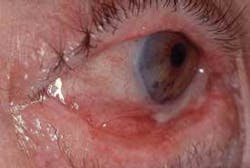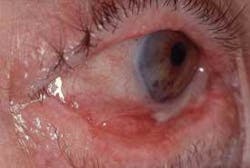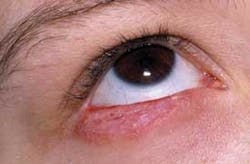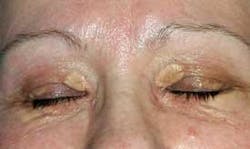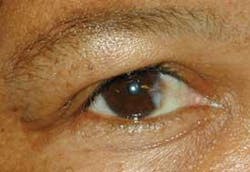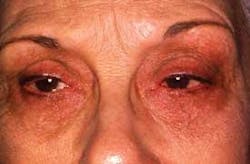The eyes have it!
by Nancy W. Burkhart, RDH, EdD
[email protected]
We have all heard the old proverb, “The eyes are the windows to the soul.” We've heard the provverb so many times that it is almost taken as a fact by most individuals. Traced back to verses in the Bible and to philosophers such as Immanuel Kant, many translations and interpretations of this proverb extend the meaning to the whole body.
A researcher in Sweden actually correlated the patterns in the iris with personality traits in 428 volunteers. His conclusions were that the various low fluctuations/frequency in crypts (squiggly lines radiating from the pupil) through the iris were significantly associated with characteristics such as tender–mindedness, kindness, warmth, trust. Extended furrows (circular lines curving around the outer edge of the iris) were linked to poor impulse control and unusual behavior.
Figure 1: Mucous membrane pemphigoid. Courtesy of Dr. Terry Rees, General and Oral Pathology for the Dental Hygienist. Lippincott Williams & Wilkins (2008).
Additionally, studies have been conducted on traits associated with whether a person looks right or looks to the left when communicating! People who look to the left are associated with emotion and subjectivity. People who look to the right are more likely associated with logic and precision (Faust, 2002). Interesting?
Figure 2: Lupus. From General and Oral Pathology for the Dental Hygienist. Lippincott Williams & Wilkins (2008).
We all know how important our eyes are to our overall well–being. When disease strikes, our eyes are noticeably affected, usually exhibiting redness, tearing, and drainage. Our eyes even show physical signs when fatigue, lack of sleep, and systemic problems occur.
Figure 3: Xanthelasma. Courtesy of Leslie DeLong, RDH, MHA.
We look into the eyes of others when we speak, and we can usually even detect reactions by just evaluating the body language through the eyes of another person. Body language is truly evident through the movement of the eyes and eyebrows. Novels depict the eyes as being wise, cold, piercing, indifferent, glaring, glazed, staring, caring, shifty, and beady. People have bedroom eyes, sleepy–eye looks, looks of steel, loving–eye looks, and so on. All of these depict characteristics of the individual's state of mind. Why do poker players wear sunglasses? Why do we teach our children to “look them straight in the eyes when speaking”?
Figure 4: Pterygium. Courtesy of Dr. Ronald Brown. Figure 5: Sjogren's syndrome. Courtesy of Dr. Terry Rees.
Yes, the eyes do tell us so much about the current physical state of the individual, as well as the person's state of mind. Cultural factors even involve the eyes. Did you know that in certain cultures, direct eye contact is an insult and a sign of disrespect? Even the length of time a person looks into the eyes of another has been researched with specific cultural evaluations applied (Alessandra & Hunsaker 1993). Additionally, in most societal groups, stares are reserved only for nonpersons. Behavior in general is correlated with the eyes. “He looked at me with his sideways glance.” “He looked at me out of the corner of his eye.” These statements depict behavioral applications.
Figure 5 Sjorgen's syndrome. Courtesy of Dr. Terry Rees
How often do health–care providers write in the chart, enter data into a computer, or look away from the patient while supposedly assessing their current physical and mental state? Paying attention to the eyes of a patient may tell us a lot about their current health status and their emotional/behavioral status. Perhaps these unwritten rules with which we view the eyes of a person, without even realizing this fact, make us stay away from truly evaluating this dynamic and information–laden part of our total well–being!
The photographs appearing with this column present some possible systemic problems that a practitioner may be able to assess in the dental office by evaluating the eyes of a patient. Sometimes, an effect on the eyes may be seen before we observe anything orally, if at all.
• Mucous membrane pemphigoid/symblepharon — Adhesions of the eye (see Figure 1) are usually associated with mucous membrane pemphigoid. The ocular involvement associated with this disease accounts for approximately 25% of patients with the disease. When the eyelid turns inward, the process is termed entropion. When the tissue extrudes outwardly, the process is termed ectropion.
The eyelashes will rub against the cornea, resulting in scarring, and this closes off the openings of the lacrimal glands as well. This produces the dryness associated with the eye involvement (Neville et al.). The patient should be referred to a specialist for further evaluation and treatment when a diagnosis of mucous membrane pemphigoid is rendered, or when eye adhesions are noticed (see related column on mucous membrane pemphigoid in March 2007 RDH).
• Lupus erythematosus — Lupus is classified as an autoimmune disease and has a predisposition for women older than 30 years. The disorder (see Figure 2) may affect the skin surfaces, the vital organs, joints, and serous membranes. A rash that extends over the nose and into the malar region is known to occur with lupus (discoid lupus erythematosus), and this is called the butterfly rash. Lupus may also affect the eyes and oral tissues as well.
• Xanthelasma — These soft, yellow–orange plaques occur near the inner canthus of the eyelid and are found more often on the upper lid than the lower (see Figure 3). The plaques may be soft and semisolid, or calcareous, single, multiple, and coalescing with varying appearances. The age range may be from 15 to 73 with a female predilection. Xanthelasma's etiology is related to elevated plasma lipid levels and low–density lipoproteins. Recent studies suggest a possible link with myeloma in some cases. Patients should be referred to their general physicians for further evaluation. The plaques are often removed with lasers and surgery.
Patients who wear glasses may not even be aware of subtle changes in the eye area. The dental practitioner may be the first health–care provider to notice an abnormality. Since glasses are always removed for the extraoral exam, and all facial tissues are routinely evaluated, the eye area is easily observed during an exam. The inner eye area is one in which patients would probably not observe an abnormality when their glasses are in place. The area under the eye frame is a prime location for skin cancers.
• Pterygium — Pterygium is the triangular growth of hypertrophied, subconjunctival tissue observed from the conjunctiva over the edge of the cornea (see Figure 4) with the apex pointing toward the pupil. The tissue may continue to grow and eventually restrict sight. Sensitivity to sunlight has been suggested as promoting pterygium in some cases. The entity may also be found in individuals with or without a diagnosed illness.
Patients with lichen planus may have eye lesions with striation and even exhibit pterygium–type triangular tissue in the eyes and also on the nails. Patients who do have such signs should be referred for evaluation of the eyes and fingernails.
Women should see their gynecologists for vaginal evaluations since there is often a problem with vaginal adhesions as well (see columns on lichen planus in these RDH issues: February 2007, January 2009, and October 2009).
• Sjogren's syndrome — Patients with Sjogren's syndrome (see Figure 5) exhibit dry eyes due to the destruction of the moisture–producing glands that include both salivary and tear ducts. Keratitis sicca is noted by extremely dry, pruritic eyes with redness and sometimes flaking skin. Since the degree of Sjogren's symptoms will vary with individuals, the dryness of the eyes may or may not be apparent to a clinician. Any such symptoms would warrant further evaluation by a specialist. Other factors such as medications may cause dryness of the eyes.
Early diagnosis of Sjogren's is important since it has been associated with the development of lymphoma. The destruction of the salivary gland tissue, discomfort for the patient, and arthritis are all key factors in further development of Sjogren's.
The proverb, “The eyes are the windows to the soul,” may be more than just the cliché that we have all come to know throughout the years.
The eyes give us important clues regarding the total health or disease states of the patient, and they are a key part of daily communication. A portion of some problems that may be observed with disease states are presented here and other significant representations are documented in the literature as well.
Keep listening to your patients, asking good questions, and do not be afraid to look at what the eyes may be telling you!
References
http://discovermagazine.com/2007/may/eyes–may–really–be–the–window–to–the–soul
Alessandra T, Hunsaker P. Communicating at work. Fireside Publishers, New York, New York. 1993.
Fast J. Body Language. MJF Books, New York, New York. 2002.
DeLong L, Burkhart NW. General and Oral Pathology for the Dental Hygienist. Lippincott Williams & Wilkins. 2008.
Ellert C, Stegeman C, Scaramucci MK. Sjogren's Syndrome. Access Dec. 2009. Pg. 22–25.
Neville BW, Damm DD, Allen CM, Bouquot JE. Oral and Maxillofacial Pathology. W.B. Saunders Co. 1995.
Nancy W. Burkhart, BSDH, EdD, is an adjunct associate professor in the department of periodontics, Baylor College of Dentistry and the Texas A & M Health Science Center, Dallas. Dr. Burkhart is founder and co–host of the International Oral Lichen Planus Support Group http://www.bcd.tamhsc.edu/outreach/lichen/ and coauthor of General and Oral Pathology for the Dental Hygienist. Her Web site for seminars is www.nancywburkhart.com.
